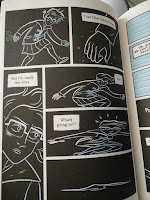Art Journal Courage: Fearless Mixed Media Techniques for Journaling Bravely by Dina Wakley (2014)
, 18 June 2022
This is another great book for beginners by art journalist extraordinaire Dina Wakley. It's packed with very easy to follow (and well photographed) tutorials, encouragement to start or continue with your art journey, and plenty of mixed-media techniques, like creating your own stencils, just to mention one that I loved.
Each chapter tries to motivate us to leave fears aside and start creating and the advice given is simple and sound:
-- Fear: I don’t know what to write! And I don’t like my handwriting. Courage: Writing takes practice! Plus, the only person who doesn’t like your handwriting is you.
-- Fear: I can’t draw. Courage: You can draw once you know the formula. And once you commit to practice!
-- Fear: I don’t want to, or know how to, include my image in my work. Courage: Examining yourself is a time-honored artistic tradition that helps you learn and grow as an artist.
-- Fear: Layering is hard. I don’t know what to do next. Courage: Breaking down the layering process into tools and methods will help you layer with confidence.
-- Fear: You don’t have the newest, trendiest art supplies so you can’t make good art. Courage: You can use supplies in unexpected ways to keep your artwork fresh and exciting!
-- Fear: I have to have everything planned in my head before I work. Courage: By working organically and intuitively, you can create interesting art and push yourself to see more.
-- Fear: Working in my journal is comfortable, but I’m afraid to move on to other projects. Courage: Moving your art from the journal page to other substrates and mixed-media projects is satisfying and exciting!
Each chapter tries to motivate us to leave fears aside and start creating and the advice given is simple and sound:
-- Fear: I don’t know what to write! And I don’t like my handwriting. Courage: Writing takes practice! Plus, the only person who doesn’t like your handwriting is you.
-- Fear: I can’t draw. Courage: You can draw once you know the formula. And once you commit to practice!
-- Fear: I don’t want to, or know how to, include my image in my work. Courage: Examining yourself is a time-honored artistic tradition that helps you learn and grow as an artist.
-- Fear: Layering is hard. I don’t know what to do next. Courage: Breaking down the layering process into tools and methods will help you layer with confidence.
-- Fear: You don’t have the newest, trendiest art supplies so you can’t make good art. Courage: You can use supplies in unexpected ways to keep your artwork fresh and exciting!
-- Fear: I have to have everything planned in my head before I work. Courage: By working organically and intuitively, you can create interesting art and push yourself to see more.
-- Fear: Working in my journal is comfortable, but I’m afraid to move on to other projects. Courage: Moving your art from the journal page to other substrates and mixed-media projects is satisfying and exciting!
The table at the end of the book with the properties, uses and downfalls of each media type is excellent.
Wakley, who has a huge range of mixed media products for sale in the craft market, doesn't promote them in the book at all, so that's really refreshing.
KINDLE EDITION
The Kindle edition is really good and the images have good resolution. Besides, the pages can be bookmarked and annotated easily, unlike other art books on Kindle.
DOWNSIDES
> The initial chapter on tools and materials is a copy-and-paste of Wakley's previous book Art Journal Freedom.
> Chapter Six starts with a big statement about the fact that we don't need expensive supplies to art journal or paint. Yet, in the tutorials included in this chapter include the use of very expensive PanPastels and Caran D'Ache Neocolors.
> I would have wanted a bit of more guidance on face shading because the book barely provides guidance on this subject.
> Chapter Six starts with a big statement about the fact that we don't need expensive supplies to art journal or paint. Yet, in the tutorials included in this chapter include the use of very expensive PanPastels and Caran D'Ache Neocolors.
> I would have wanted a bit of more guidance on face shading because the book barely provides guidance on this subject.
TYPOS
Bold is missing from the words 'fear' and 'courage' at the start of chapter 6.













.png)
.png)
.png)

.png)
.png)
.png)












































